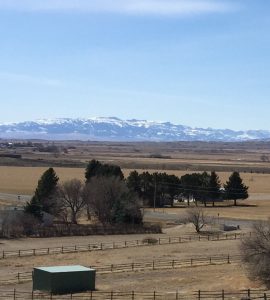Pat Stuart
Books and Columns

THEN AND NOW
by Pat Stuart
Powell Tribune, 1 November 2018
Running for a seat on the county commission gave me not just permission but an obligation to ring doorbells. To do so entailed a lot of driving along the roads of our ag lands.
Sometimes as I pulled into yards, particularly on the Heart Mountain project, I felt like one of my feet had landed in a time warp and the other was hovering in mid-air. Memories of the past pushed aside the present … to the degree that it brought back old vocabulary. Like thinking of the ag areas as “the projects.”
That’s what everyone once called most of what came to be our irrigated land back when the Bureau of Reclamation was still bringing thousands of acres of Park County’s high desert under water.
“Bringing … under water.” That’s another bit of language from my childhood that resurfaced. Turning into driveways, I’d look around for more, finding evidence of a remembered past in the sizes and shapes of the otherwise well-disguised barracks that had come off the Heart Mountain Relocation Center.
The Barracks

Even the word ‘barracks’ means something different now. It fails to conjure up the tar-paper shack segments that the last wave of homesteaders carted off to their designated bit of desert.
You’d scarcely know them. Their original owners—the World War II veterans–remodeled their shacks into every kind of farm building imaginable, including lovely homes.
Knocking on doors, I wondered if they would open into a building where my friends and I had once played. That had been in the late 40’s when the Admin housing at the camp was occupied by Bureau of Reclamation families.
As kids, we’d chalk out hop scotch boxes on the floor planks, then mark how well we could jump by the hollow thuds of our feet and the squeaking protest of rusty nails. Bored with that, we’d replace cob webs with cloth from our moms’ rag bags and play house or castle. Together with the boys, we climbed guard towers to look out over the camp and watch our play houses cut up, loaded onto flatbeds, and disappear down the road.
Guard Towers

That ended when Andrea Hull fell from the top of one to shatter an arm. Shortly after, the towers disappeared, too, their timbers and planks headed, like the barracks, for what their new homesteading owners hoped would be a prosperous future.
It isn’t easy to envision now what these young folks, most with small children, felt as they dropped their buildings onto ground they’d cleared of sagebrush, bunch grass, and cactus, covering the exit holes of rattlesnakes and rabbits, listening to the wind and the coyotes.
Barely sixty years has passed, but their lives were as different from ours now as those of the Pilgrims. The government had provided them with land. Yes.
But after that Uncle Sam, the state, and the county were out of their lives. They had no medical safety nets, few services, and fewer guarantees of what they’d eat or when there’d be a next meal. They wore what we’d call grossly inadequate clothing in the winter and suffered afflictions we don’t recognize. Like chilblains. The list of differences can go on and on.
But, frankly, I revel in how it is now, driving roads that neatly border rich farmland, the barley harvest in full swing; beats and alfalfa, verdant and rich and waiting the baler or digger. The homesteads—struggle though it has been—have fulfilled every hope of those who, quite literally, worked their fingers to the bone.
The Struggle to Prosper
More to the point, though, the barracks—still there under the camouflage—are a reminder that the struggle to prosper remains as onerous as it was in the 40’s. Only the nature of the struggle has changed. The present is a hard place for a small farmer in a world where his land is worth more if it grows houses. His or hers, now, is a world dominated by giant agribusinesses and by a complex government bureaucracy. His or hers is a future of hard choices.
And more about what I heard on those subjects in another column.

Ideas and words to provoke thought…